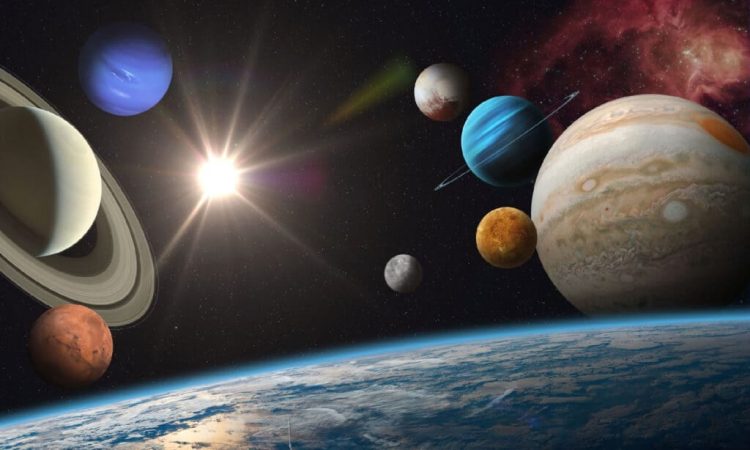Exploring the Vast Diversity of Planet Sizes in Our Universe

In the vast tapestry of the cosmos, planets come in a staggering array of sizes, ranging from tiny rocky bodies to colossal gas giants. The sheer diversity of planet sizes is a testament to the complexity and beauty of our universe. In this article, we will embark on a journey to explore the various sizes of planets, from the smallest exoplanets to the giants that defy our imagination.
I. The Smallest: Mini-Neptunes and Super-Earths
At the lower end of the planetary size spectrum, we encounter Mini-Neptunes and Super-Earths. Mini-Neptunes, as the name suggests, are small gas giants with sizes between that of Earth and Neptune. These planets challenge our understanding of planetary formation and composition.
Super-Earths, on the other hand, are rocky planets with masses larger than Earth but significantly smaller than Uranus or Neptune. They might have thick atmospheres or even oceans, making them intriguing candidates in the search for potentially habitable exoplanets.
II. Earth-like Planets: Our Home and Beyond
Earth, with its diverse ecosystems and ideal conditions for life, is a reference point for many discussions about habitable planets. However, as we explore the cosmos, we find other Earth-like planets, both in terms of size and conditions. These planets, often situated in their star’s habitable zone, offer the tantalizing possibility of hosting extraterrestrial life.
The study of exoplanets has revealed a multitude of Earth-sized planets, sparking interest in understanding their atmospheres, compositions, and potential habitability. Telescopes like the Kepler Space Telescope have played a crucial role in this quest, providing a wealth of data that continues to shape our understanding of planetary systems.
III. Gas Giants: The Giants of the Solar System
Moving up the size scale, we encounter gas giants like Jupiter and Saturn, behemoths dominating our own solar system. These planets consist mainly of hydrogen and helium and lack solid surfaces. Their colossal sizes make them fascinating subjects of study, with swirling storms, intricate ring systems, and a myriad of moons.
Jupiter, the largest planet in our solar system, is more than 11 times the diameter of Earth. Its immense gravity influences the dynamics of the entire solar system, and its Great Red Spot, a massive storm, has intrigued astronomers for centuries. Saturn, adorned with its iconic ring system, captivates our imagination with its stunning beauty.
IV. Beyond Our Solar System: Exoplanetary Giants
The discovery of exoplanets has expanded our understanding of planet sizes beyond the confines of our solar system. Some exoplanets, known as Hot Jupiters, defy our expectations by orbiting their host stars in close proximity. These gas giants, despite their colossal sizes, experience intense heat due to their proximity to their parent stars.
The diversity of exoplanets doesn’t stop at Hot Jupiters. Some systems boast multiple gas giants, while others feature bizarre configurations that challenge our understanding of planetary formation. Studying these distant worlds provides valuable insights into the variety of planetary systems that exist in the cosmos.
V. The Search for Dwarf Planets
In addition to the well-known planets, our solar system is home to a category of celestial bodies known as dwarf planets. Pluto, once considered the ninth planet, was reclassified as a dwarf planet due to its smaller size and different characteristics from the traditional planets.
Beyond Pluto, other dwarf planets, such as Eris and Haumea, orbit the Sun in the distant reaches of the solar system. These small, icy bodies offer a glimpse into the mysterious Kuiper Belt, a region populated by numerous small objects that could provide clues about the early solar system’s formation.
VI. Rogue Planets: Wandering Nomads of the Cosmos
Not all planets are tethered to a star. Rogue planets, also known as free-floating planets, drift through the cosmos without a host star to orbit. These nomadic worlds present a unique set of challenges for astronomers, as they are difficult to detect directly. Some estimates suggest that there may be as many rogue planets as there are stars in our galaxy, highlighting the vastness of these uncharted celestial wanderers.
Conclusion:
The exploration of planet sizes takes us on a cosmic journey from the smallest rocky bodies to the colossal gas giants that dominate their solar systems. As our understanding of exoplanets continues to evolve, we uncover a wealth of diversity that challenges our preconceptions about planetary formation and composition. The study of planets, both within and beyond our solar system, is a testament to humanity’s insatiable curiosity and our ongoing quest to unravel the mysteries of the universe.
-
What is the smallest planet in our solar system?
The smallest planet in our solar system is Mercury. It is a rocky planet and the closest to the Sun.
-
What is the largest planet in our solar system?
Jupiter holds the title of the largest planet in our solar system. It is a gas giant with a diameter of more than 86,881 miles (139,822 kilometers).
-
Are there planets smaller than Earth in the universe?
Yes, there are exoplanets smaller than Earth. These include Super-Earths, which have a larger mass than Earth but are still rocky in composition.
-
Do all planets have atmospheres?
No, not all planets have atmospheres. Rocky planets like Mercury and Mars have thin atmospheres, while gas giants like Jupiter and Saturn have thick and complex atmospheres.
-
What is a gas giant?
A gas giant is a type of planet primarily composed of hydrogen and helium. Jupiter and Saturn in our solar system are examples of gas giants.
-
Are there planets with multiple moons?
Yes, many planets, especially gas giants, have multiple moons. For instance, Jupiter has over 80 known moons, including the four largest known as the Galilean moons.
-
What are Hot Jupiters?
Hot Jupiters are a type of exoplanet that is similar in size to Jupiter but orbits very close to their parent stars, resulting in high temperatures.
-
Are there planets outside our solar system?
Yes, thousands of exoplanets have been discovered beyond our solar system. These planets vary in size, composition, and orbital characteristics.
-
Why is Pluto considered a dwarf planet?
Pluto is considered a dwarf planet due to its smaller size, unique orbit, and characteristics that differentiate it from the traditional planets. It was reclassified by the International Astronomical Union in 2006.
-
What are rogue planets?
Rogue planets, or free-floating planets, are not bound to any star and wander through space independently. They are challenging to detect directly and may outnumber stars in our galaxy.
-
Can Earth-sized exoplanets be habitable?
Earth-sized exoplanets within their star’s habitable zone, where conditions may support liquid water, are considered potential candidates for habitability. The study of their atmospheres is crucial in assessing their habitability.
-
How do astronomers measure the size of exoplanets?
Astronomers use various methods to measure the size of exoplanets, including the transit method (observing a planet passing in front of its star) and the radial velocity method (detecting the star’s wobble caused by the planet’s gravitational pull).
-
Are there planets with extreme temperatures?
Yes, some exoplanets experience extreme temperatures. Hot Jupiters, for example, can have surface temperatures reaching thousands of degrees Celsius due to their proximity to their parent stars.
-
What is the Kuiper Belt, and how does it relate to dwarf planets?
The Kuiper Belt is a region of the solar system beyond Neptune that is populated by small, icy bodies. Some dwarf planets, like Pluto and Eris, are located in the Kuiper Belt, offering insights into the early solar system’s formation.
-
Do planets influence the orbits of other planets?
Yes, planets can influence each other’s orbits through gravitational interactions. Jupiter, with its massive size, has a significant impact on the dynamics of the entire solar system.
Exploring the various aspects of planet sizes provides a glimpse into the rich diversity of celestial bodies that exist both within and beyond our solar system.






